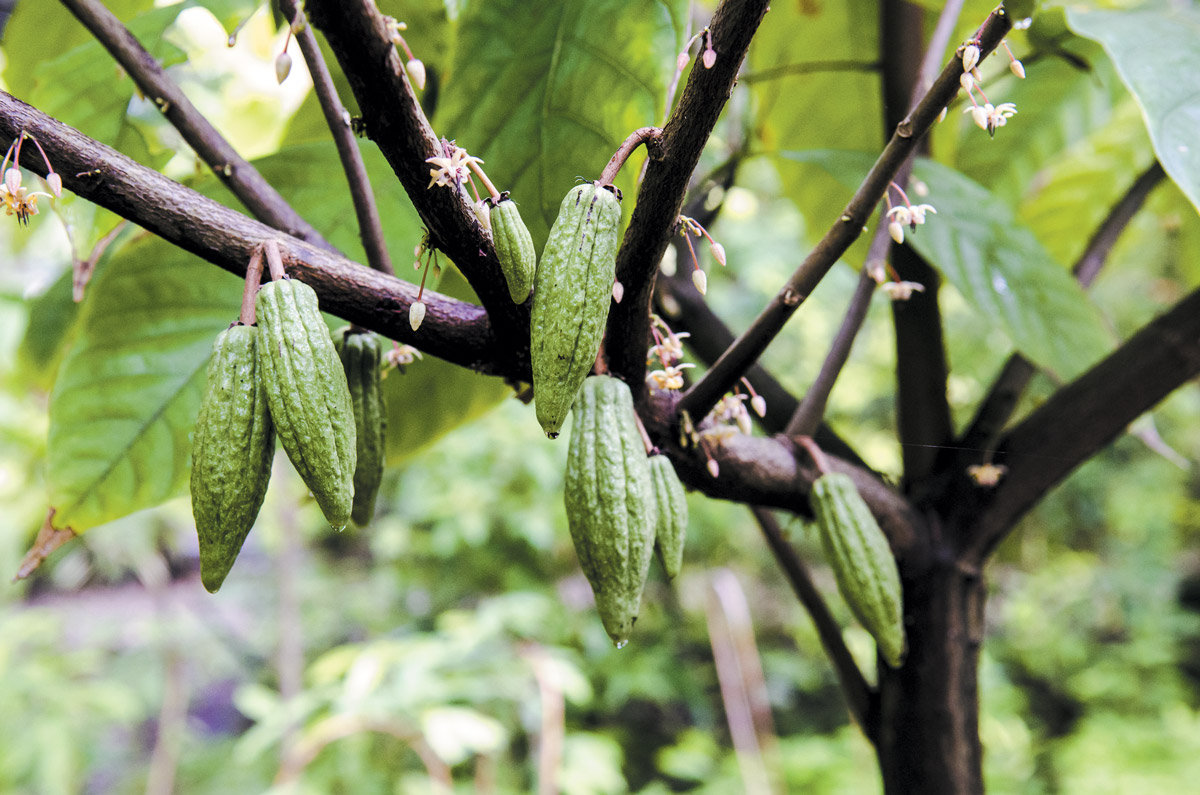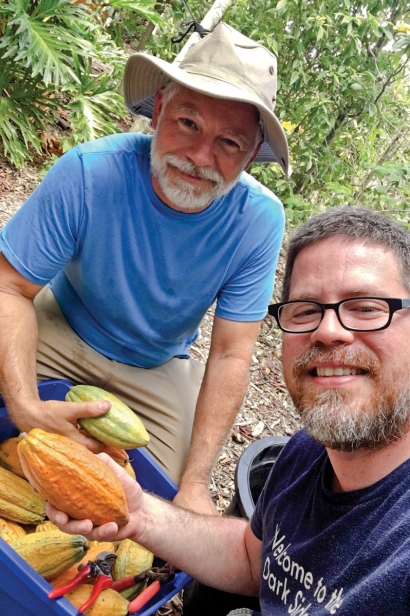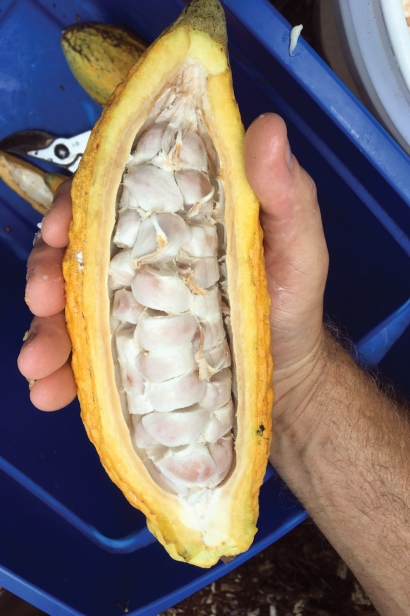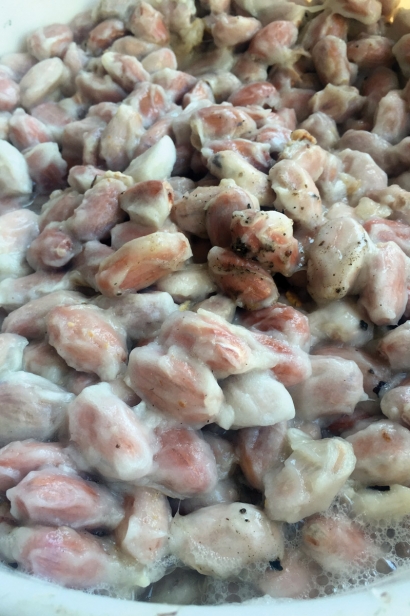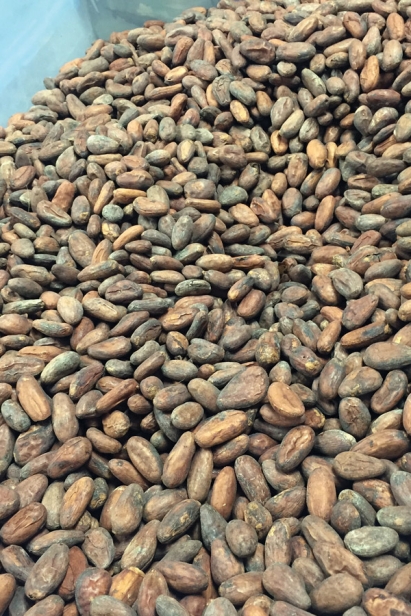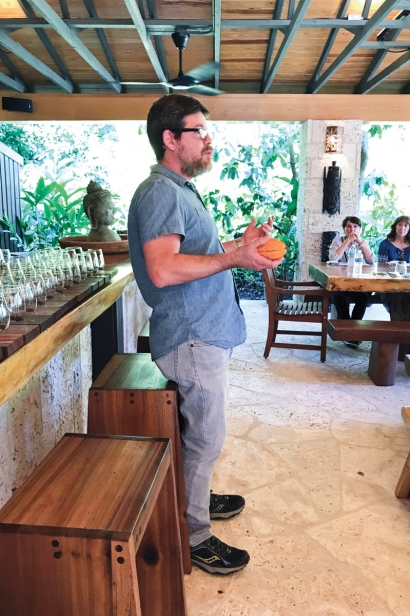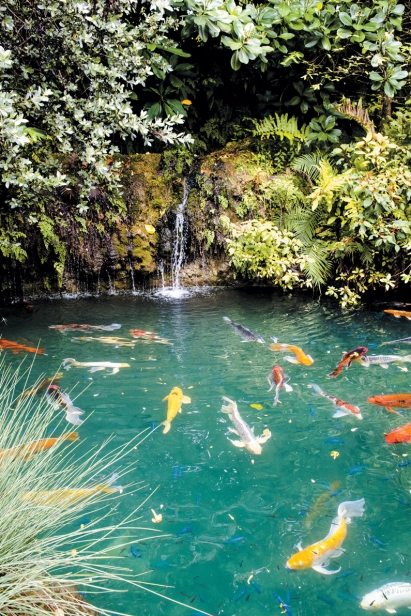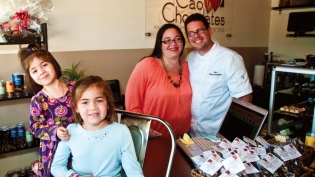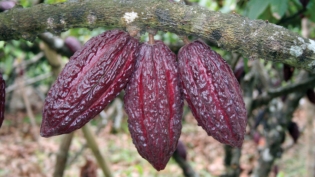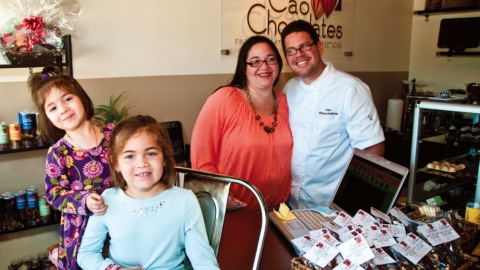Tree-to-Bar Chocolate in South Florida
A working cacao farm in South Florida may have been unthinkable not long ago. Native to central and northern South America, cacao (Theobroma cacao) thrives in hot, humid tropical areas where temperatures never reach freezing. Only Hawaii and Puerto Rico have been able to support cacao plantations.
Fewer cold nights and freezes in South Florida are changing what farmers plant. Cacao trees do grow and fruit here – at the USDA ARS Subtropical Horticultural Research Station known as Chapman Field, at Fairchild Tropical Botanic Garden, at the Rare Fruit and Vegetable Council of Broward County in Southwest Ranches, and in the backyards of adventurous gardeners. Horticulturists Fred Hubbard and Roberto Del Cid, responsible for the 20-acre Patch of Heaven Gardens in the Redland, started growing cacao in 2010 with a couple of trees picked up by owners Bruce and Joyce Chesney at the Fairchild International Chocolate Festival.
“Roberto and I knew they would be sensitive to cold, so we planted them close to the main house in the forest,” says Hubbard. “It wasn’t until 2013 that we realized a warming trend in the weather and the trees started to flower.” At that point, they looked more seriously at cacao. “We had a large open area under massive Delonix regias that was begging for something fantastic, so we decided to plant a cacao grove.”
They planted some seedlings from their tree in Tegucigalpa, Honduras, but they “kind of stumbled along. Roberto reached out to a friend in Ecuador who visited us and gave us some pointers, but it really all boiled down to soil type issues. So we knew we needed genetic diversity.” They picked up more seedlings and planted them in 2014. He recalls only one cold night that winter season, and not much cool weather since, so the cacao trees have been fruiting. Over the past few years, they’ve have been taking the fruit to grow more trees that thrive in our alkaline soils.
Enter the Chocolate Maker
Last year, the Patch of Heaven cacao trees were producing enough fruit to be used to make chocolate. Hubbard contacted Ricardo “Cao” Trillos, a bean-to-bar chocolatier in Pinecrest (featured in our fall 2013 issue), who had met Bruce Chesney at Fairchild’s chocolate festival. Trillos toured the grove and it seemed like an ideal match. “Our goal is to produce a private label of locally grown chocolate for consumers who like to know where their food comes from,” says Hubbard.
“We started this bean-to-bar process in Miami many years ago, and we received cacao beans from all over the world,” says Trillos. “When we realized we had the actual opportunity to grow and go through the process of farming this, we wanted to pioneer and take over the risk.”
Over the past year, the team has worked together to produce two batches of the first tree-to-bar chocolates. “Roberto is tending to growing the trees, I monitor the trees for health and fruit production, and Ricardo and I harvest and work on fermenting,” says Hubbard. “Ricardo is taking our cacao beans and leading us in fermentation, drying and producing our product. It has become very much a team effort.” Their work is a precursor to plans for building a cacao production plant on a larger scale: buying more land, planting more cacao trees, and working on bigger facilities for fermenting, drying and chocolate making.
Savoring Chocolate
At the same time, Trillos, a relentless educator in his shop, at chocolate festivals and at events, talks chocolate at a monthly tasting at Patch of Heaven. After he and Hubbard lead a tour of the gardens and cacao trees, Trillos explains the process and passes around different chocolates for analysis. “Whatever you think you know about chocolate, we can change your horizons,” he tells the group. “People love specialty food, but don’t understand that chocolate is one, like wine, scotch, bourbon, cheeses.” He advises them to let the chocolate melt in their mouth slowly and explore the flavor notes: coffee, cinnamon, toffee, nutmeg. “If you’re gonna drink a great scotch, you take your time,” he says. “Craft chocolate is exactly the same.”
Clearly, the prospect of being the first in this endeavor is exciting for everyone who cares about bringing food from the land to the table. “I believe we will end up being similar to wine growers. Depending on the number of fruit from a tree in any given year, our flavors will vary,” says Hubbard. “However, it will always be locally grown. From my understanding, we are the very first commercial producers of chocolate in the continental United States,” he says. Celebrated author, culinary historian and chocolate expert Maricel E. Presilla agrees: “Growing cacao in South Florida – it’s not a folly. It’s a small miracle! For someone to have the pleasure of hands-on growing in a cacao grove, I know what it feels like. I’m glad a chocolate maker is doing it.” Trillos believes the best is yet to come. “Together, we will put South Florida on the map with this project.”
Harvesting Cacao
Hubbard and Trillos gather ripe cacao pods. Inside, the beans are covered in white fleshy cacao pulp, sweet and tangy. These seeds are placed in a wooden fermentation box, and covered with banana leaves and burlap bags to increase the heat. During the fermentation process, which can take a few days to a week, the pulp disappears, the flavors develop in the beans, and they turn from light to brown. The beans are then dried to make sure all the moisture is removed in order to store the beans for months or years. From here, the chocolate maker takes over: beans are roasted, then broken up to remove the shell from the cocoa nibs. The nibs are ground into a paste, sugar and any other ingredients are added. The chocolate is then conched – mixed in a machine for hours or days – to develop texture and flavor, and stored to age further. Finally, the chocolate is tempered, a process of melting and cooling so that the final product is shiny and breaks with a snap.
Chocolate Tastings and Tours at Patch of Heaven
Every month, Ricardo Trillos hosts a chocolate tasting at this 20-acre estate in the Redland, just west of Monkey Jungle. Originally owned by the pioneer Matheson family in the 1960s, the property was sold in the 1980s and used as a petting farm. The neighboring ornamental growers Costa Farms then bought the property and used the structures as farm worker housing. In 2008, Bruce and Joyce Chesney purchased 11 acres of the land and set out to restore the buildings and preserve the hammock. Horticulturists Fred Hubbard and Roberto Del Cid worked on creating the magnificent gardens throughout the property: a koi-filled grotto, coral rock-lined water gardens, pathways lined with towering gingers and fragrant flowering trees. Visitors get a tour of the property and the hundreds of cacao trees planted throughout, followed by a chocolate tasting and dinner paired with wines in the open-air Balinese pavilion.
Monthly Chocolate Tastings
For tickets and future dates: caochocolates.com
Find Cao Chocolates at his shop and at Milam's Markets, Panther Coffee, Books and Books and other retailers.
Patch of Heaven Sanctuary
21900 SW 157 Ave., Miami


